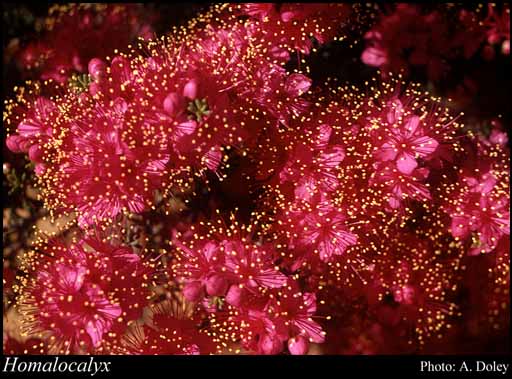- Reference
- Hooker's J.Bot.Kew Gard.Misc. 9:309 (1857)
- Name Status
- Current







Scientific Description
Family Myrtaceae.
Includes Wehlia F. Muell.
Habit and leaf form. Shrubs; evergreen; bearing essential oils. Plants with neither basal nor terminal concentrations of leaves; to 0.5–1.5 m high. Leptocaul. Helophytic to xerophytic. Leaves minute to small; alternate (floral leaves and hence inflorescences sometimes in whorls of 3 in H. aureus); ‘herbaceous’, or leathery; petiolate to subsessile; gland-dotted; aromatic; edgewise to the stem, or with ‘normal’ orientation; simple; epulvinate. Leaf blades dorsiventral, or isobilateral, or centric; entire; flat, or rolled, or solid (usually), or flat (when lunate); terete, or semi-terete, or solid/angular; linear, or lanceolate, or oblong, or ovate; linear, or ovate, or obovate, or oblong, or elliptic; pinnately veined, or parallel-veined, or one-veined; cross-venulate, or without cross-venules. Leaves with stipules. Stipules caducous, or persistent. Leaves without a persistent basal meristem. Stem anatomy. Secondary thickening developing from a conventional cambial ring.
Reproductive type, pollination. Fertile flowers hermaphrodite. Unisexual flowers absent. Plants hermaphrodite. Entomophilous, or ornithophilous. Pollination mechanism conspicuously specialized (via stylar modification for passive pollen presentation), or unspecialized.
Inflorescence and flower features. Flowers solitary, or aggregated in ‘inflorescences’ (apparently); 1 per axil. The terminal inflorescence unit cymose. Inflorescences 1-flowered, the inflorescences in the floral zone clustered or scattered. Flowers pedicellate (may be interpreted as pedunculate); (bi) bracteolate. Bracteoles persistent (free or basally connate). Flowers small to large; regular; 5 merous; cyclic. Free hypanthium present (petals ‘inserted on the calyx’); tubular (or rounded or subrounded); extending beyond ovary; short, pubescent or glabrous. Hypogynous disk present. Perianth with distinct calyx and corolla; 10; 2 -whorled; isomerous. Calyx present; 5; 1 -whorled; polysepalous, or gamosepalous (depending on interpretation). Calyx segments entire (or erose). Calyx erect, or spreading (reflexed); imbricate; exceeded by the corolla to more or less equalling the corolla; regular; persistent, or not persistent. Sepals elliptic, or oblong, or ovate, or obovate, or triangular, or orbicular. Calyx lobes elliptic, or oblong, or ovate, or obovate, or triangular, or orbicular. Corolla present; 5; 1 -whorled; polypetalous; imbricate; regular; white, or yellow, or red, or pink, or purple, or violet; deciduous. Petals elliptic, or oblong, or ovate, or obovate, or orbicular. Corolla members entire (or erose). Androecial members indefinite in number. Androecium 15–115. Androecial members branched. Androecial sequence determinable, or not determinable. Androecial members if ‘many’, maturing centripetally; free of the perianth; all equal; free of one another; 1 -whorled, or 2 -whorled. Stamens 15–115; attached on the rim of the hypanthium; triplostemonous to polystemonous; alternisepalous and oppositisepalous; both opposite and alternating with the corolla members; inflexed in bud (usually), or erect in bud (in H. ericaeus). Anthers dorsifixed; versatile; dehiscing via longitudinal slits; introrse; tetrasporangiate; appendaged, or unappendaged. Gynoecium 2 carpelled. The pistil 1 celled. Gynoecium syncarpous; eu-syncarpous; partly inferior. Ovary unilocular; 1 locular. Ovary summit glabrous. Epigynous disk absent. Gynoecium stylate. Styles 1; simple; apical; persistent, or deciduous; hairless. Stigmas 1; capitate, or punctiform (and minute). Placentation axile- basal. Ovules in the single cavity 2(–4); ascending; non-arillate; anatropous.
Fruit and seed features. Fruit non-fleshy; indehiscent; a nut (the hypanthium in fruit morphologically little changed from the hypanthium in flower); 1 seeded. Seeds non-endospermic; cylindrical, subobconoid, subturbinate, depressed subglobose or reniform; winged, or wingless. Cotyledons 2; minute, on a slender hypocotylar neck curled around the apex of the cylindrical, relatively massive, hypocotyl. Embryo curved.
Geography, cytology, number of species. Native of Australia. Endemic to Australia. Australian states and territories: Western Australia, Northern Territory, and Queensland. Northern Botanical Province, Eremaean Botanical Province, and South-West Botanical Province. N=11.
Keys
A Key to Western Australian Species in the Chamelaucieae Tribe of Myrtaceae
B.L. Rye, M.D. Barrett, T.D. Macfarlane, N.S. Lander, M.E. Trudgen, N.G. Marchant, K.R. Thiele
Taxonomic Literature
- Wheeler, J. R.; Rye, B. L.; Koch, B. L.; Wilson, A. J. G.; Western Australian Herbarium 1992. Flora of the Kimberley region. Western Australian Herbarium.. Como, W.A..